The Intel Comet Lake Core i9-10900K, i7-10700K, i5-10600K CPU Review: Skylake We Go Again
by Dr. Ian Cutress on May 20, 2020 9:00 AM EST- Posted in
- CPUs
- Intel
- Skylake
- 14nm
- Z490
- 10th Gen Core
- Comet Lake
CPU Performance: Web and Legacy Tests
While more the focus of low-end and small form factor systems, web-based benchmarks are notoriously difficult to standardize. Modern web browsers are frequently updated, with no recourse to disable those updates, and as such there is difficulty in keeping a common platform. The fast paced nature of browser development means that version numbers (and performance) can change from week to week. Despite this, web tests are often a good measure of user experience: a lot of what most office work is today revolves around web applications, particularly email and office apps, but also interfaces and development environments. Our web tests include some of the industry standard tests, as well as a few popular but older tests.
We have also included our legacy benchmarks in this section, representing a stack of older code for popular benchmarks.
All of our benchmark results can also be found in our benchmark engine, Bench.
Speedometer 2: JavaScript Frameworks
Our newest web test is Speedometer 2, which is a accrued test over a series of javascript frameworks to do three simple things: built a list, enable each item in the list, and remove the list. All the frameworks implement the same visual cues, but obviously apply them from different coding angles.
Our test goes through the list of frameworks, and produces a final score indicative of ‘rpm’, one of the benchmarks internal metrics. We report this final score.
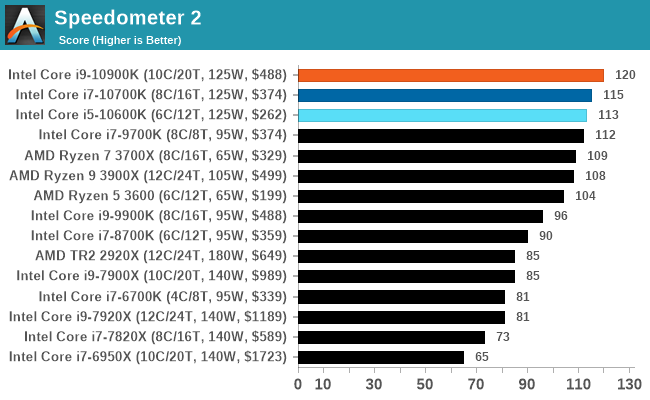
Google Octane 2.0: Core Web Compute
A popular web test for several years, but now no longer being updated, is Octane, developed by Google. Version 2.0 of the test performs the best part of two-dozen compute related tasks, such as regular expressions, cryptography, ray tracing, emulation, and Navier-Stokes physics calculations.
The test gives each sub-test a score and produces a geometric mean of the set as a final result. We run the full benchmark four times, and average the final results.
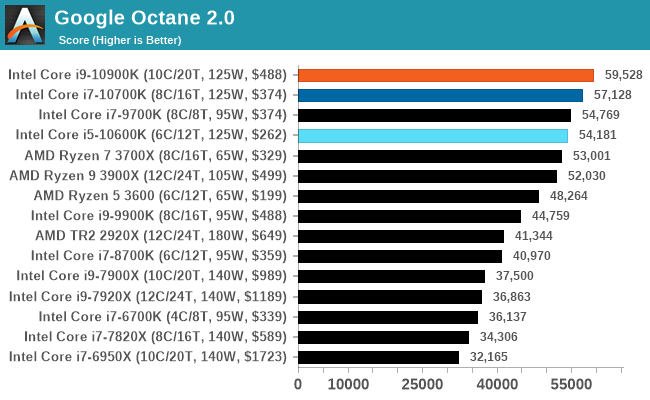
Mozilla Kraken 1.1: Core Web Compute
Even older than Octane is Kraken, this time developed by Mozilla. This is an older test that does similar computational mechanics, such as audio processing or image filtering. Kraken seems to produce a highly variable result depending on the browser version, as it is a test that is keenly optimized for.
The main benchmark runs through each of the sub-tests ten times and produces an average time to completion for each loop, given in milliseconds. We run the full benchmark four times and take an average of the time taken.
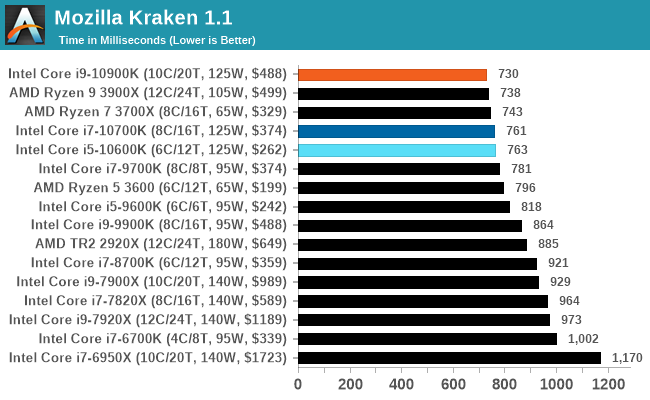
3DPM v1: Naïve Code Variant of 3DPM v2.1
The first legacy test in the suite is the first version of our 3DPM benchmark. This is the ultimate naïve version of the code, as if it was written by scientist with no knowledge of how computer hardware, compilers, or optimization works (which in fact, it was at the start). This represents a large body of scientific simulation out in the wild, where getting the answer is more important than it being fast (getting a result in 4 days is acceptable if it’s correct, rather than sending someone away for a year to learn to code and getting the result in 5 minutes).
In this version, the only real optimization was in the compiler flags (-O2, -fp:fast), compiling it in release mode, and enabling OpenMP in the main compute loops. The loops were not configured for function size, and one of the key slowdowns is false sharing in the cache. It also has long dependency chains based on the random number generation, which leads to relatively poor performance on specific compute microarchitectures.
3DPM v1 can be downloaded with our 3DPM v2 code here: 3DPMv2.1.rar (13.0 MB)
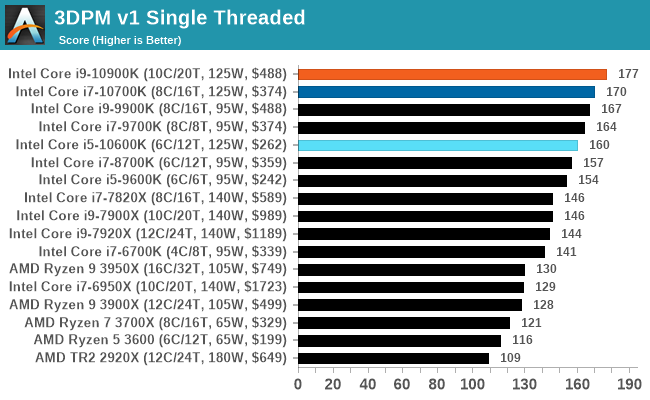
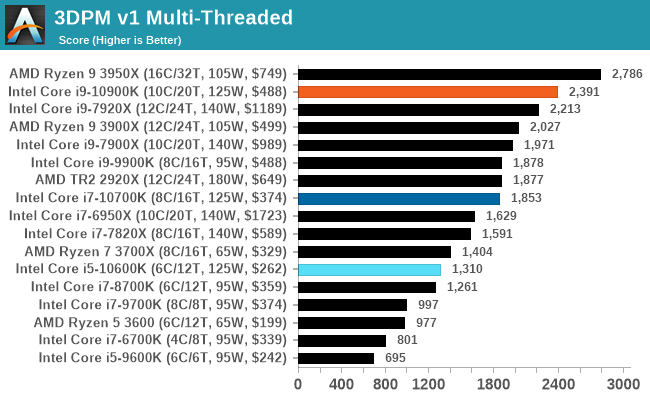
x264 HD 3.0: Older Transcode Test
This transcoding test is super old, and was used by Anand back in the day of Pentium 4 and Athlon II processors. Here a standardized 720p video is transcoded with a two-pass conversion, with the benchmark showing the frames-per-second of each pass. This benchmark is single-threaded, and between some micro-architectures we seem to actually hit an instructions-per-clock wall.
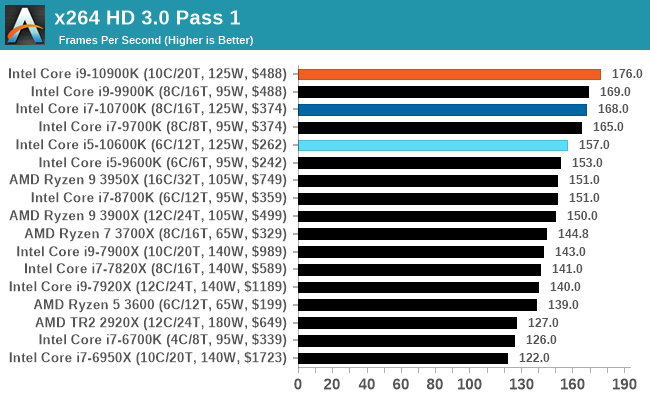
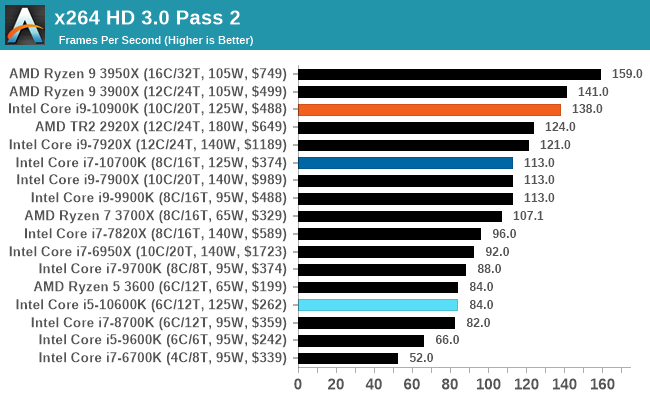










220 Comments
View All Comments
arashi - Sunday, May 24, 2020 - link
Replacing Stewart with xx does not a clone account make.Try again.
Spunjji - Tuesday, May 26, 2020 - link
Good catch XDSpunjji - Tuesday, May 26, 2020 - link
You're talking past yourself.Sure, it's impressive what Intel's disaster management engineers managed to pull out the wreckage of their failure at 10nm. Their failure at 10nm was an engineering failure too, though, and they still haven't managed to backport their 10nm-planned architecture to 14nm.
In other words, those engineering failures are the only reason they had to build this crazy nonsense - of which you express such admiration - in the first place.
extide - Wednesday, May 20, 2020 - link
This is not HEDTSpunjji - Tuesday, May 26, 2020 - link
He's still reading from the 2016 Intel playbook :DIcehawk - Saturday, May 23, 2020 - link
I care because I like silent machines and use fanless PSUs. I can’t afford to blow 250-300W of the power budget on the CPU when I am limited to 450W, the small difference in real world gaming isn’t worth popping for a higher power PSU that brings with it fan noise. I should be able to run my 3900X with a nV 3070 with what I have, I don’t think I could with this i9.If power budget isn’t a concern then it’s down to brand preference, usage mix, etc to me. I have an intel 8700 as well, at the time I felt that was the best CPU choice, when I needed another new machine a few months ago the 3900 was - I still feel it would be today for me.
YMMV
Spunjji - Tuesday, May 26, 2020 - link
Cool, another person who thinks their personal views on a topic outweigh all others and is psychologically projecting that onto the reviewer. This is how 90% of disinformation works now...prophet001 - Wednesday, May 20, 2020 - link
I'm curious as to why this only has 16 pcie lanes into the CPU. How much does running your high performance SSD through the PCH or running your GPU in x8 mode affect performance?GreenReaper - Wednesday, May 20, 2020 - link
Conveniently, there is an article (almost) about that: https://www.anandtech.com/show/15720/intel-ghost-c...azfacea - Wednesday, May 20, 2020 - link
with intel DIY PC marketshare being well below 50% and 10th gen itself having to compete with 9th, 8th, 7th, with supply shortage and everything I doubt these new LGA1200 motherboards can reach 10% of DIY PC which means the" ... 44+ entrants ranging from $150 all the way up to $1200 ..."
are all massive cash burning operations that would never make sense in a million years w/- intel "development funding". they are literally squandering billions of dollars that they took from ripping of the customers. intel is so stupid, gouging its customers like this and then squandering the money for what ?? LGA 1200 has the option to have pcie 4 by the time its irrelevant ? my god WTF is going on there.